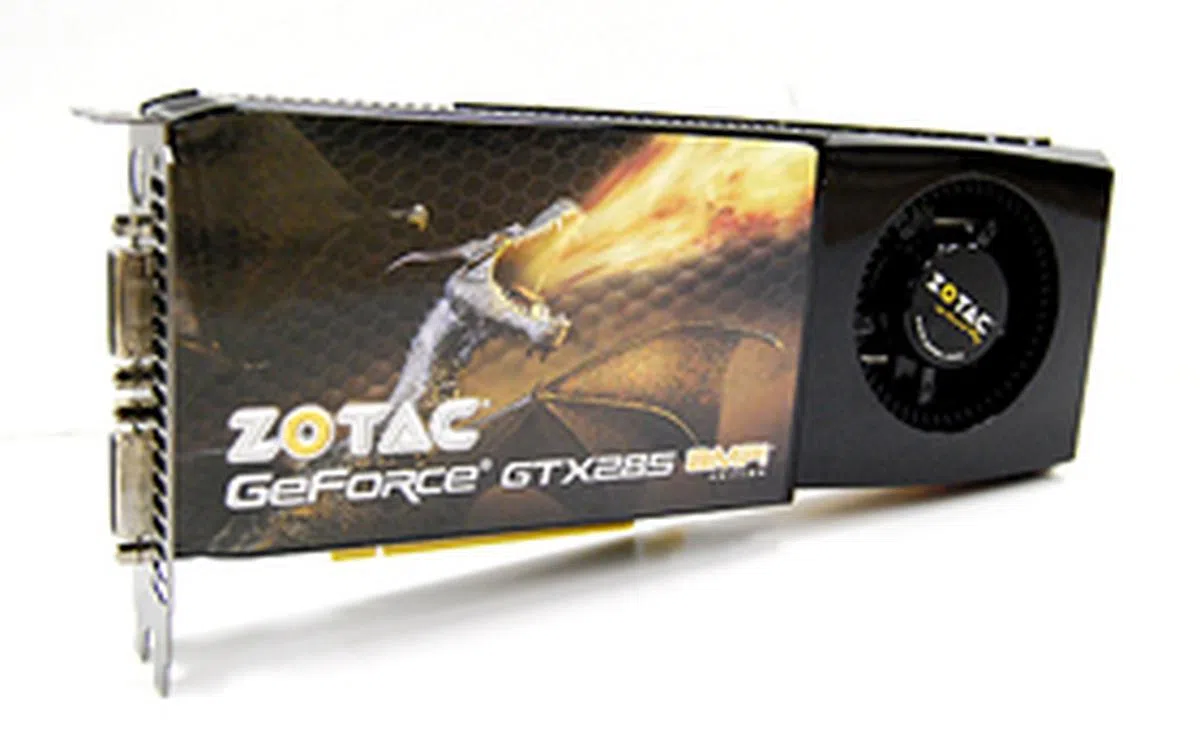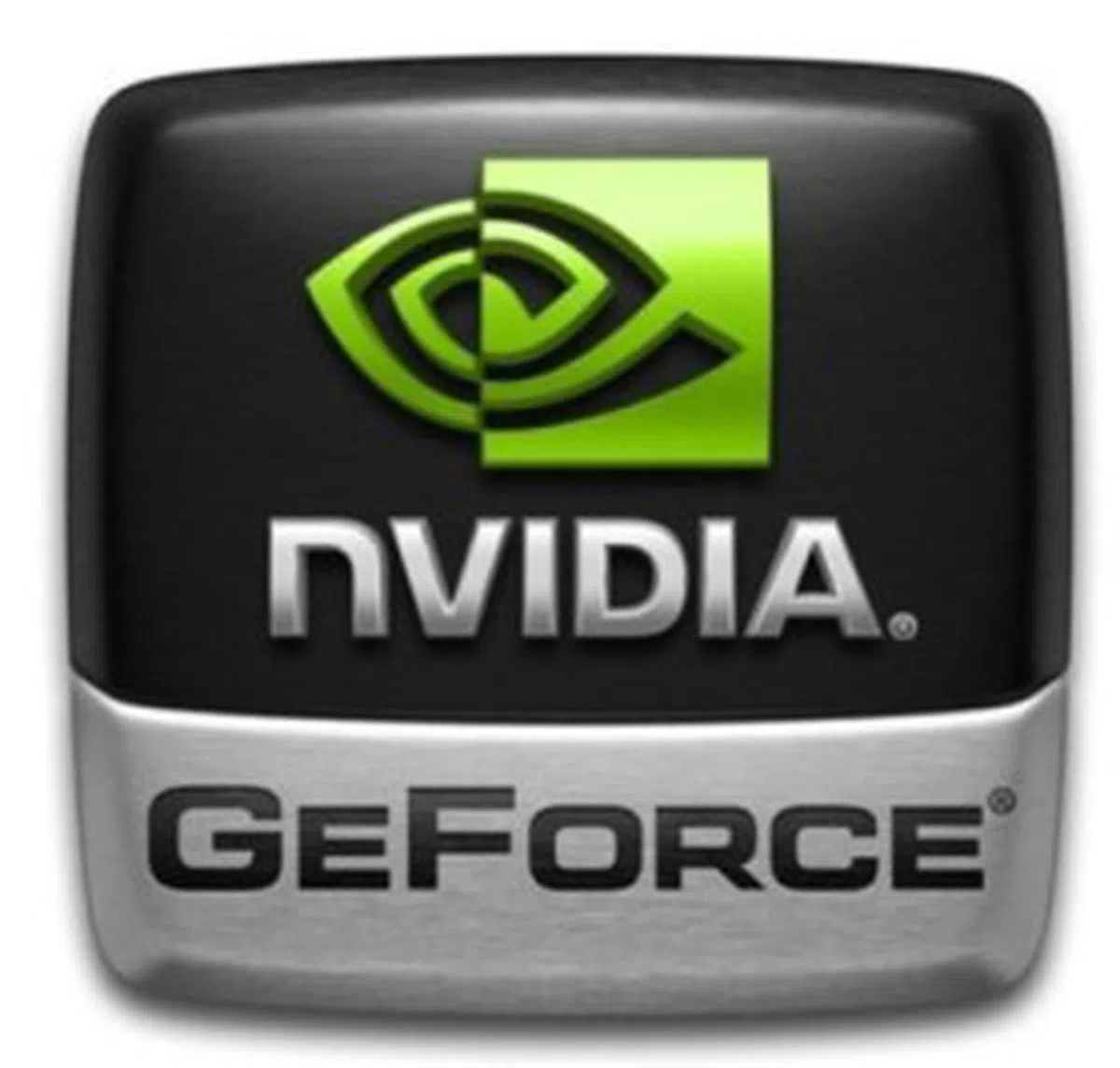Cementing First Place - NVIDIA GeForce GTX 285
Shrouded behind the hype surrounding the new GeForce GTX 295 is the GeForce GTX 285. Essentially a 55nm refresh of the GTX 280, NVIDIA says it will provide up to 10% more performance while consuming up to 20W less power. Sounds too good to be true? Join us for the full revelation.
By Kenny Yeo -
55nm GeForce GTX 280 Makeover = GTX 285
The new GeForce GTX 295 was not the only new graphics card unveiled by NVIDIA at this year's Consumer Electronics Show (CES). In fact, lost amidst all the hype and commotion surrounding NVIDIA's new dual-GPU sandwich is the newest and fastest single GPU king, the GeForce GTX 285. And with it, NVIDIA hopes to cement their offering as the fastest single GPU available in the market.
At heart is a 55nm refresh of the GeForce GTX 280, but the new GeForce GTX 285 also boasts several other features and enhancements that NVIDIA promises will make it faster, quieter and more efficient than the GTX 280.

NVIDIA is making some pretty tall claims here with their new GeForce GTX 285. Faster, yet cooler and more efficient? We'll soon find out if those claims are valid.
Although the manufacturing process technology for the GPU on the GeForce GTX 285 has been shrunk, it still retains its 240 shader processors. Elsewhere, clock speeds have been beefed up: 648MHz at the core, 2484MHz DDR at the memory (still GDDR3 though), and 1476MHz at the shaders. As you'll find out from the table below, this is quite a substantial increase as compared to the original GTX 280 model and we should see a noticeable increase in performance.
Additionally, another significant improvement to the GeForce GTX 285 is its power consumption. While the older GeForce GTX 280 has a maximum rated TDP of 236W, the new GTX 285 is rated at only 189W. And because of that, it longer requires a 6 and 8-pin power connector. Instead, only two 6-pin power connectors are required.

from the Zotac GeForce GTX 285 AMP! Edition. Clock speeds are factory-overclocked.
Model | NVIDIA GeForce GTX 285 1GB GDDR3 | NVIDIA GeForce GTX 280 1GB GDDR3 | ATI Radeon HD 4870 512MB GDDR5 | NVIDIA GeForce GTX 260 Core 216 896MB GDDR3 | NVIDIA GeForce GTX 295 1792MB GDDR3 | ATI Radeon HD 4870 X2 2GB GDDR5 |
Core Code | GT200 | GT200 | RV770 | GT200 | GT200 x 2 | R700 (RV770 x 2) |
Transistor Count | 1400 million | 1400 million | 956 million | 1400 million | 2800 million | 1912 million |
Manufacturing Process | 55nm | 65nm | 55nm | 65nm/55nm | 55nm | 55nm |
Core Clock | 648MHz | 602MHz | 750MHz | 576MHz | 576MHz | 750MHz |
Stream Processors | 240 Stream Prcoessors | 240 Stream Processors | 160 Processors (800 Stream processing units) | 216 Stream Processors | 480 Stream Processors | 320 Processors (1600 Stream processing units) |
Stream Processor Clock | 1476MHz | 1296Mhz | 750MHz | 1242MHz | 1242MHz | 750MHz |
Texture Mapping Units (TMU) or Texture Filtering (TF) units | 80 | 80 | 40 | 72 | 160 | 80 |
Raster Operator units (ROP) | 32 | 32 | 16 | 28 | 56 | 32 |
Memory Clock | 2484MHz GDDR3 | 2214MHz GDDR3 | 3600MHz GDDR5 | 1998MHz GDDR3 | 1998MHz GDDR3 | 3600MHz GDDR5 |
DDR Memory Bus Width | 512-bit | 512-bit | 256-bit | 448-bit | 448-bit | 256-bit |
Memory Bandwidth | 159GB/s | 141.7GB/s | 115.2GB/s | 111.9GB/s | 223.8GB/s | 230GB/s |
PCI Express Interface | PCIe ver 2.0 x16 | PCIe ver 2.0 x16 | PCIe ver 2.0 x16 | PCIe ver 2.0 x16 | PCIe ver 2.0 x16 | PCIe ver 2.0 x16 |
Molex Power Connectors | 2 x 6-pin | 6-pin, 8-pin | 2 x 6-pin | 2 x 6-pin | 6-pin,8-pin | 6-pin, 8-pin |
Multi GPU Technology | Yes (SLI) | Yes (SLI) | Yes (CrossFireX) | Yes (SLI) | Yes (SLI) | Yes (CrossFireX) |
DVI Output Support | 2 x Dual Link | 2 x Dual-Link | 2 x Dual-Link | 2 x Dual-Link | 2 x Dual-Link, 1 x HDMI | 2 x Dual-Link |
HDCP Output Support | Yes | Yes | Yes | Yes | Yes | Yes |
Street Price | US$399 | ~US$429 | ~US$209 | ~US$259 | US$499 | ~US$449 |
The Zotac GeForce GTX 285 AMP! Edition 1GB GDDR3
Despite the fact that the GeForce GTX 285 already boasts some impressive clock speeds, Zotac somehow saw fit to boost them even further. The Zotac GeForce GTX 285 AMP! Edition is the latest addition to their AMP! Edition of factory-overclocked cards and its clock speeds are rather impressive - 702MHz at the core, 2592MHz DDR at the memory and 1512MHz at the shaders. This should really give us some compelling performance.
Other than the increased clock speeds, the Zotac GeForce GTX 285 AMP! Edition looks no different from all other GTX series cards in our labs. If the stickers were all peeled off from their reference coolers, you'll be hard pressed to tell one from the other.

As you can see, the new GeForce GTX 285 retains the GT 200's signature big black brick look.

Without the stickers, you'll be hard pressed to tell the two apart. But if you must, the GeForce GTX 285 can be identified by its two 6-pin power connectors. The older GTX 280 requires a both 6 and 8-pins power connectors.

The Zotac GeForce GTX 285 AMP! Edition has the usual two HDCP-compliant DVI outputs and 7-pin mini-DIN.

One of the biggest revisions of the GeForce GTX 285 is its use of two 6-pin power connectors. Don't be fooled though, as far as graphics cards go, it's not going to win any eco-awards. You can also see the same S/PDIF digital audio input header.

Two SLI connectors on the GeForce GTX 285 come as standard, meaning two or three-way SLI is possible.
Also, this was what the Zotac GeForce GTX 285 AMP! Edition came with:
- Driver CD
- Quick installation guide
- A copy of Racedriver Grid game
- A copy of 3DMark Vantage Advanced
- 1 x DVI to VGA adapter
- 1 x DVI to HDMI adapter
- 2 x Molex to 6-pin PCIe power connector
- 1 x S/PDIF cable
Test Setup
We'll be testing the Zotac GeForce GTX 285 AMP! Edition on our Vista system, which has the following specifications:
Windows Vista SP1 Test System
- Intel Core 2 Extreme QX6850 (3.00GHz)
- Gigabyte X38T-DQ6 motherboard
- 2 x 1GB DDR3-1333 Aeneon memory in dual channel mode
- Seagate 7200.10 200GB SATA hard drive
- Windows Vista Ultimate with SP1
Alongside the Zotac GeForce GTX 285 AMP! Edition, we also have a reference clocked GTX 285, and your usual suspects of uber high-end graphics cards. This should give us a good idea of where the new GeForce GTX 285 stands amongst the other graphics card juggernauts.
The complete list of cards tested and their driver versions:
- Zotac GeForce GTX 285 AMP! Edition (ForceWare 181.20)
- NVIDIA GeForce GTX 285 1GB GDDR3 (ForceWare 181.20)
- NVIDIA GeForce GTX 280 1GB GDDR3 (ForceWare 180.48)
- ATI Radeon HD 4870 512MB GDDR5 (Catalyst 8.12)
- NVIDIA GeForce GTX 260 Core 216 896MB GDDR3 (ForceWare 180.48)
- NVIDIA GeForce GTX 295 1792MB GDDR3 (ForceWare 181.20)
- ATI Radeon HD 4870 X2 2GB GDDR5 (Catalyst 8.12)
The GeForce GTX 285 will be tested on the following games/software using their built-in time demos or benchmarking tools:
- Futuremark 3DMark06
- Futuremark 3DMark Vantage
- Crysis Warhead
- Far Cry 2
- Left 4 Dead
- Unreal Tournament 3
Windows Vista Results - 3DMark06
The new GeForce GTX 285 strutted its stuff right from the get-go, posting 3DMark06 scores that were about 5-10% higher than the GTX 280. Needless to say, the factory-overclocked Zotac GeForce GTX 285 AMP! Edition recorded even higher scores that could almost rival that of the dual-GPU GeForce GTX 295. Clearly, performance on 3DMark06 for the GeForce GTX 295 doesn't scale very well, reminding us that dual-GPU cards are only as good as the drivers that drive them. It also easily left ATI's fastest single GPU card, the Radeon HD 4870, in the dust.


Windows Vista Results - 3DMark Vantage
On 3DMark Vantage, the Zotac GeForce GTX 285 continued its fine form, recording 3DMarks that could almost rival ATI's Radeon HD 4870 X2 flagship. Again, the ATI Radeon HD 4870 had no answer and the performance difference between the two was as wide as 50%. This could be partly because of its much smaller 512MB frame-buffer. Nonetheless, comparing the two here gives us a rough idea of just how much more powerful NVIDIA's single GPU is compared to ATI's.

Windows Vista Results - Crysis Warhead & Far Cry 2
Coming to real world benchmarking with Crysis Warhead, the Zotac GeForce GTX 285 AMP! Edition certainly didn't disappoint, recording frame-rates that were comfortably above the playable 30fps threshold up until anti-alising was activated. The regular GeForce GTX 285 didn't do too bad either, delivering on NVIDIA's promise of 10% performance increases over the older GTX 280.


On Far Cry 2, the Zotac GeForce GTX 285 AMP! Edition and regular GTX 285 both managed to put up very playable frame-rates even on our highest settings. The same, however, cannot be said of the Radeon HD 4870 which began to stutter badly when we turned the quality of anti-aliasing up to 8x. Clearly, 512MB is not enough if you wish to play games at the highest settings.


Windows Vista Results - Left 4 Dead & Unreal Tournament
On Left 4 Dead, the Zotac GeForce GTX 285 AMP! Edition was so fast that it could even challenge the Radeon HD 4870 X2 on the lower resolutions. The regular GTX 285 again showed sizeable performance gains over the GTX 280.


Coming to Unreal Tournament 3, the Zotac GeForce GTX 285 AMP! Edition stood out for having frame-rates that surpassed even that of the ATI Radeon HD 4870 X2. However, it must be noted that Unreal Tournament 3 generally fares better on NVIDIA cards, so maybe that could explain the Zotac's blazing performance.

Temperature
NVIDIA claims that thanks to the GeForce GTX 285's new 55nm manufacturing process, the new cards will not only run faster, but also cooler. Sadly, our results show otherwise. At 81 degrees Celsius, it about as hot as the older GTX 200 cards and is even warmer than the twin GPU GeForce GTX 295. We said this many times before and we'll say it again, the cards from the GTX 200 series are desperately crying out for a new cooler. Still, credit must be given where credit is due, and we must say that the cooler on the Zotac GeForce GTX 285 AMP! Edition was surprisingly smooth and quiet.

Power Consumption
NVIDIA promises the new GeForce GTX 285 to use about 20W less power and as you can see from the graph, our findings wholly supports that claim. Naturally, being factory-overclocked, the Zotac GeForce GTX 285 AMP! Edition requires even more juice to run. Having said that, we were particularly impressed with how NVIDIA has managed to bring down their cards' idle power consumption to such low levels.

Overclocking
The Zotac GeForce GTX 285 AMP! Edition already comes factory-overclocked at a rather heady 702MHz at the core, but using NVIDIA Control Panel, we managed to push it up to 740MHz, nearly 100MHz above the GTX 285's reference clock speed of 648MHz. As for the memory, we managed to bring it up to a stratospheric 2800MHz DDR. The net result is a 10% performance boost over a reference GeForce GTX 285 which is the same delta of difference between itself and the original GTX 280 model. Overall, quite decent indeed.

A Minor Refresh
NVIDIA is definitely picking up steam. Their new flagship, the GeForce GTX 295, is an absolute storm of a graphics card, and shortly after its launch, ATI was forced to slash prices of their flagship Radeon HD 4870 X2 cards by as much as US$100 to US$449.
However, unlike the GeForce GTX 295, the GeForce GTX 285 is not as groundbreaking and its successes are no where near the scale of that achieved by its more powerful sibling. Sure, it does improve upon performance and efficiency, but it's not to the same extent as what the GeForce GTX 295 did. And without a Radeon HD 4850 X2 on hand, we cannot say with certainty if the GeForce GTX 285 is the best card in its price and performance segment. However, as far as single GPUs go, NVIDIA has clearly one-upped themselves here. The GeForce GTX 285 is certainly an improvement over the GTX 280.
In the same breath, the Zotac GeForce GTX 285 AMP! Edition is a step up over the standard GTX 285. It might not have a fancy customized cooler or LED lights and such, but it performs as it was expected to consistently. In all, it is yet another solid offering from Zotac.
Of course, as is the case with high-end cards, be prepared to pay through your nose. The GeForce GTX 285 is expected to launch at US$399 (S$592), while the Zotac GeForce GTX 285 AMP! Edition, on the other hand, is expected to be released with a recommend retail pricing of US$419 (S$621). Herein lies the problem, because in today's uncertain times, how many would put down over half a grand's worth for a graphics card?

The Zotac GeForce GTX 285 AMP! Edition is an excellent take on the GeForce GTX 285, offering great performance with little or no sacrifice on efficiency.
As we have mentioned before, NVIDIA needs to transfer some of the technological know-how and features of their GTX 200 cards over to their mid-range, mainstream ones. Sadly, it's been more than six months since the GTX 280 was launched and we've yet to see anything concrete. NVIDIA, it seems for the moment, is content to continue renaming and rehashing cards for their mid-range offerings.
Nevertheless, for those who only want and expect the very best, the GeForce GTX 285 is definitely one for you to consider. It is without a shadow of a doubt the fastest single GPU available (nothing from ATI can touch it), and with it, you won't have to worry about things such as scaling and driver support as you would with dual-GPU solutions. Is this the fastest single GPU solution? A resounding yes. But is it the best? That is open to debate...
 |  |
 |  |
Our articles may contain affiliate links. If you buy through these links, we may earn a small commission.